Soccer drills for technique passing
- Pass-roulette in diamond shape.
- 1 passes to 2.
- 2 passes to 1.
- 1 passes to 3.
- 3 passes to 4.
- 4 joins the line.
- Some points of attention:
- Must roll ball off to begin the drill.
- Must pass ball short (not a one meter pass).
- Must control ball and then pass.
- Must stand with back to sideline and take ball with furthest foot.
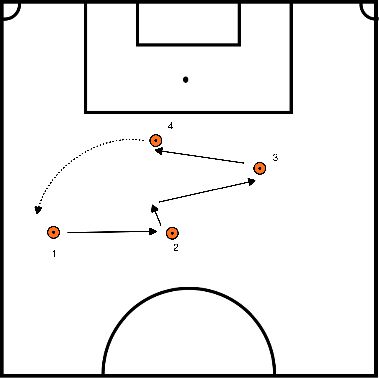
- Possibly double line up.
- 2 trainers.
- Duration 10 min.
- Goalkeeper 1 kicks out to goalkeeper 2 (long ball).
- Goalkeeper 2 controls and builds up attack via A1.
- A1 plays on opposite flank A2 .
- A1/A2 and goalkeeper 2 build on goal K1.
- Defenders join in.
- Passing attackers become defenders.
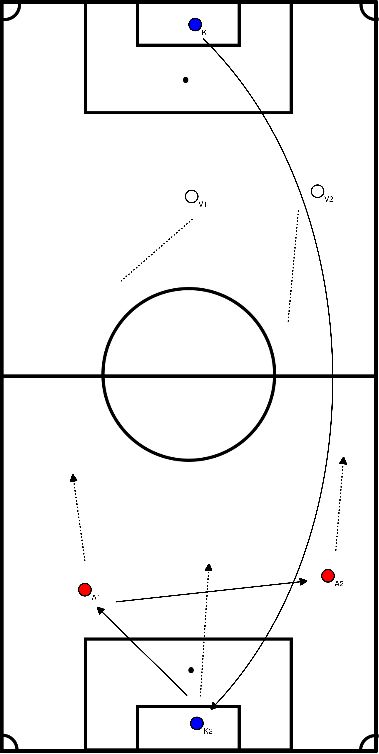
- Circle with full group.
- Trainer stays on 1 position.
- All players have 1 ball.
- 1 player in the middle.
- Orientate well once where everyone is standing.
- Trainer calls the player by name who passes the ball to the middle player, who tries to control the ball as good as possible, and turns and passes to the trainer.
- Repeat this until the balls are gone.
- Pass in triangle shape then with handball.
- Players on the outside run after the ball.
- 2 central pawns stay in place for 2 minutes before changing.
- Emphasis on passing:
- Pass.
- Accuracy.
- Coaching other players.
- If necessary double line up depending on the number of players.
- Distance 15 to 20 meters.
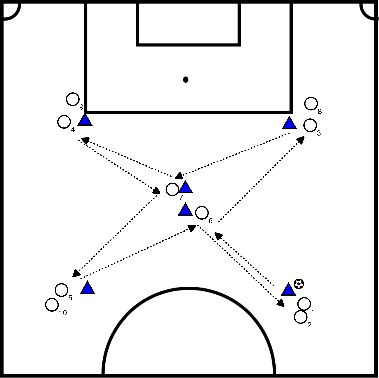
- Finish during the opening turn and/or after the handball 15 - 20 minutes.
- Variant 1 with opening twist.
- Player 1 passes to player 2.
- Player 1 walks to the pawn of player 2.
- Player 2 turns open and passes to player 3.
- Player 2 walks to the pawn of player 3.
- Player 3 turns open and shoots directly at goal.
- Player 3 retrieves the ball and passes to player 4.
- Variant 2 with handball.
- Player 4 plays into player 5.
- Player 4 runs to the pawn of player 5.
- Player 5 turns open and plays into player 6.
- Player 5 runs to and shows where he wants the ball.
- Player 6 looks where player 5 wants the ball and bounces it there.
- Player 5 rebounds the ball on the 11 meter and then quickly runs back to the pawn near player 6.
- Player 6 starts running when the ball is played and shoots the ball on goal.
- Retrieve the ball quickly and join player 1 at the back.
- With 9 - 10 players this exercise is so good.
- If you have 12 or more players, use the following variation.
- These three points are then a replacement of point 1.
- Player 7 passes the ball to player 1(or 6).
- Player 1(0f 6) rebounds the ball diagonally and walks to the pawn of player 2(or 5).
- Player 7 runs into the ball and plays the ball to player 2(or 5).
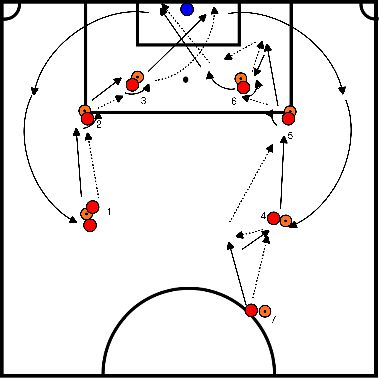
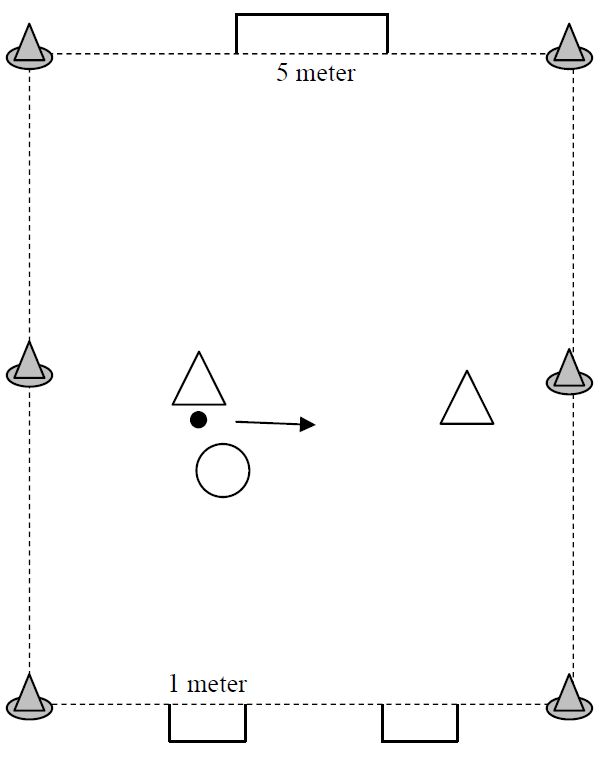
Organization:
The game is played 2 against 1. If there are 2 players left they play 1:1 on a smaller field.
The pair tries to score on the 2 little goals.
After about 8 minutes the players are changed.
If the 2 team has it too easy, you can move the 2 goals closer together.
Remarks:
Because of the many 1:1 duels you can soon see if they are doing well or not so well. Don't
give them instructionsin the first
game. Give them the chance to improve themselves.
Points of attention:
Prevent the opponent from shooting at goal.
Position yourself in such a way that it is difficult for your opponent to pass to his/her team-mate
Organisation:
On 2 fields 3:3, 4:4 or 4:3 is played.
You can score with a dribble through one of the two little goals.
First try to encourage them to make passing moves.
If that is going well, you can also try to make sure they make the right choice between passing and playing over.
After about 10 minutes a different opponent.
Remarks:
When changing opponents, you can indicate which nice passing actions you have seen.
Points of attention:
Do not use the passing move too far or too close to the opponent.
The body must move with the passing move in order for it to be successful.
Organisation:
On 2 or 3 fields play 4:4, 3:3 or 2:2.
Encourage shooting from distance.
Points of attention:
Technical execution of the kick with the inside of the foot
: Stand leg; point in the direction of play; bent at the hip, knee and ankle.
Playing leg; turned outward; knee and ankle bent.
Playing foot; perpendicular to the direction of play; sole of the foot parallel to the ground; toes raised;
no weak ankleon the
kick.
A controlled swinging movement.
Technical execution of the kick with the inside of the instep
:Stand leg; 2 to 3 foot widths next to the ball; bent at the knee.
Tackle; on the inside of the spot where the laces begin.
Approach from an angle of approximately 45º.
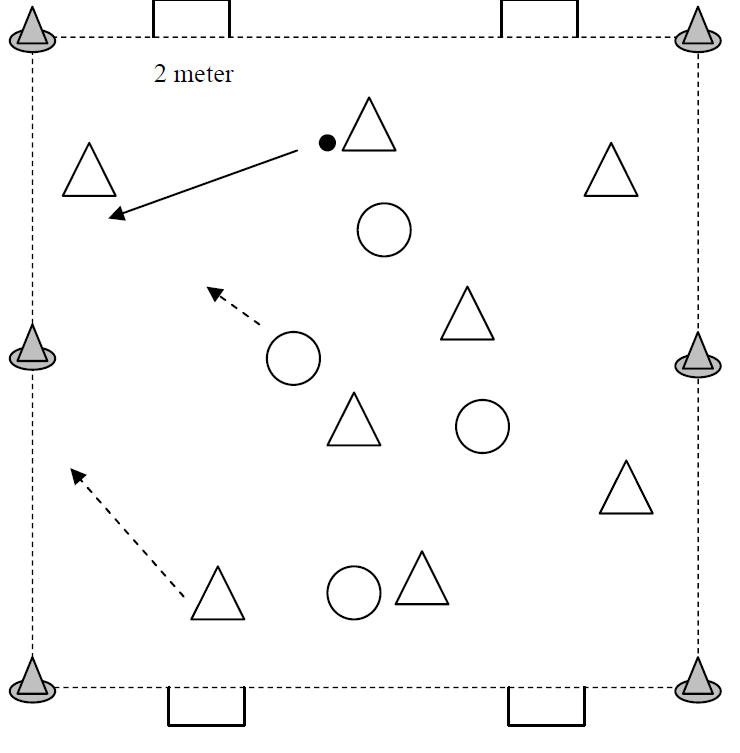
Organisation:
The game will be played 8:4.
6:3, 7:3, 7:4, 9:4 or 9:5 is also possible.
With more or less players the size has to be adjusted.
The 8-team may score after 5 replays.
The 4-player team may always try to score.
When the ball is intercepted by the foursome, when it goes out or after a goal has been scored, a new count must be made.
count again.
After, in total, 5 goals or after 10 minutes substitute.
To make it easier or more difficult, the number of replays can be changed.
Points of attention:
Use the left and right foot.
If possible, keep the ball low
.
Correct ball speed.
Play directly.
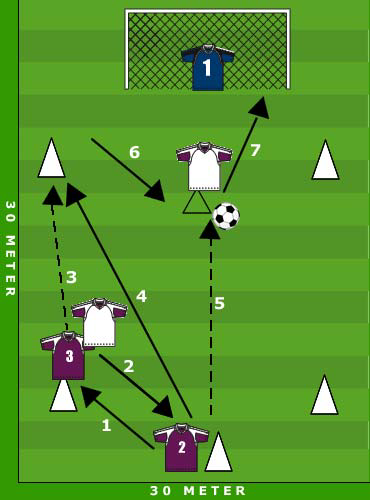
Field position:
1 starting pawn at 30 meters from the goal. A defender at 10 meters from the goal. A goalkeeper on the goal. A second defender with the rising attacker.
Sequence of play:
According to the numbering in the diagram, the pass from the attacker through the midfielder is played deep. The defender runs with the attacker while the midfielder runs towards the goalkeeper to get the ball there and tries to score.
Rules/tips:
- Defenders start at 50% effort and increase it later.
- Make sure the ball is played deep.
- The cross can be hit from the left or from the right.
- A variation on this is to play with 2 midfielders and have 1 run towards the far post.
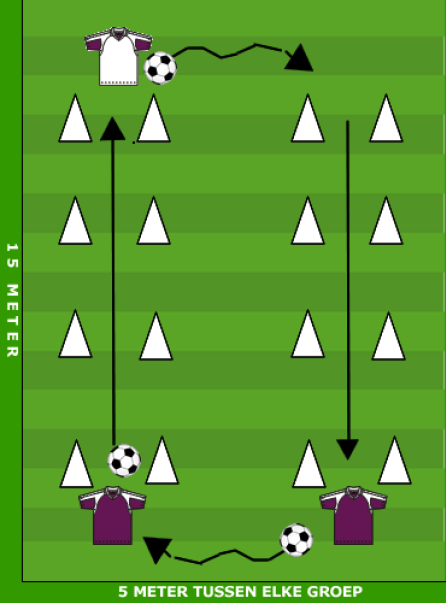
Field position:
Line up 2 x 4 x 2 pawns side by side to create two streets of pawns.
How to play:
Players must try to pass exactly through the street of pawns and then sprint through it chasing the ball. Another player (white) receives the ball and dribbles to the other street. There this player does exactly the same towards player 3.
Player 3 starts again on the same spot as player 1.
Rules of play:
- The ball must go through the street of pawns.
- If you hit a pawn, you must sprint to set it straight and try again.
- The ball must pass all cones before the receiving player can receive it.
Field setup:
Line up 2 Pawns per player group opposite each other with starting 5 meters in between. Later this can be extended to 10 or 15 metres.
How the game progresses:
The players must try to knock over each other's cone.
Rules of the game:
- You are not allowed to stand in front of your cone but must always stand behind it.
- When you shoot, you can put the ball on the left or the right side of the cone.
- If you hit the cone you get 1 point.
- When the trainer whistles you have to change with another player.
- You may not stand opposite the same player.







